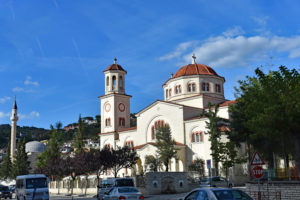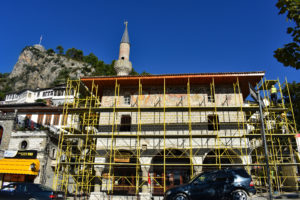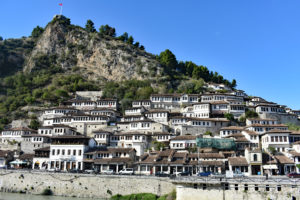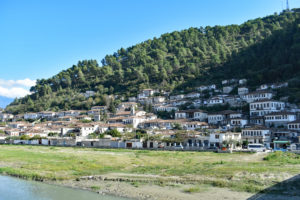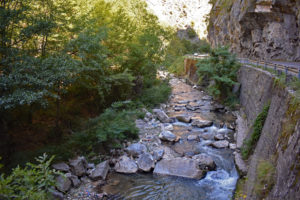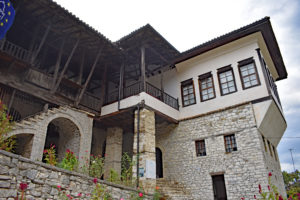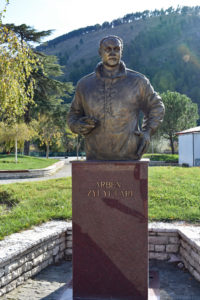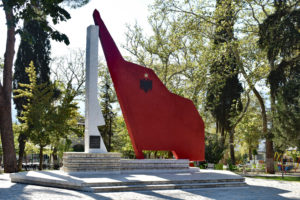The city of Berat in central Albania, is often covered as a day trip from Tirana but, as we were staying for two nights at the “Rezidenca Desaret”:https://www.silvertraveladvisor.com/review/accommodation/201573-review-rezidenca-desaret, we not only spent time in “Berat Castle”:https://www.silvertraveladvisor.com/review/attraction/201645-review-berat-castle and “Onufri Museum”:https://www.silvertraveladvisor.com/review/attraction/201756-review-onufri-museum, but our guide, Mikeli, took us around town.
However, before leaving the Castle, he pointed out sights from its high vantage point. This included the new cathedral (the original had been destroyed during the communist era) and adjacent mosque which demonstrated religious harmony. The impressive capitol-like building was built by a rich Albanian originally as a private university (which was on our guidebook map). However, as there were good state universities, it was little used, and is now being transformed into a five-star hotel. It was hard to miss a large concrete building which had been a textile factory, called Mao Tse Tung, which during the communist period employed 10,000 people working 24 hours a day in 3 x 8 hours shifts. We also saw the striking Mount Shpiragu range, or striped mountains: in the 1930s the Italians constructed a piped water supply system from the mountains to the citadel.
Our walking tour then began back down in the town.
KINGS MOSQUE – unfortunately the mosque is undergoing Turkish funded restoration, however there were a couple of photos on the hoarding. There are three parts to the site: the mosque, the Halveti Teke (one of 12 types of Islam said to involve lots of trance like dancing), the dormitory where the pilgrims would have stayed overnight with rooms on the first floor and stabling underneath. This is the most important mosque and used for Friday prayers.
BACHELOR MOSQUE – when we initially passed the mosque, yellow scaffolding was in the process of being dismantled, so later in the day, we were able to see the refurbished frescoes of flora and fauna on the top level. It’s called the bachelor mosque due to its location near the Ottoman bazaar where many of the shopkeepers were single. The minaret was very short to keep it in proportion with the houses, apparently another sign of religious tolerance.
There are two sides to the town: Mangalemi and Gorica.
MANGALEMI QUARTER – these houses are formed in a semi-circle which stretches south and east around the base of the castle. They are thought to be the first houses built outside the castle walls during the 15th and 16th centuries. The unique architecture combines stone and wood and all the houses are similar. Now, there are around 60 families living in the area, known as 1001 windows, which kept them light inside before electricity. The houses tend to have two or three intergenerational families living in them and are usually handed down, as people take pride in owning homes. It is a stunning sight, and much photographed particularly in the morning when it catches the sun.
GORICA QUARTER – this area of housing, of the same style as Mangalemi, was across the Usumi river and we walked up the quiet, peaceful, narrow cobbled lanes. The houses are on the lowest part of a hill with a pre-Roman fortification on top.
GORICA BRIDGE – was the old Ottoman Bridge and built in 1777. It had been ordered by a Pasha but the builders and council leaders prevaricated, so the Pasha threw a bag of gold coins into the river to signify he had money to throw away, and the best possible bridge was built in stone. However, it was destroyed by floods and was frequently repaired until 1930 when the current bridge was built. At 130m long, it has 9 semi-circular arches and connects the Gorica and Mangalemi quarters. A British firm of architects were commissioned to build the sides and incorporated a Union Jack into the design.
MODERN SUSPENSION BRIDGE – the location of this slightly wibbly-wobbly bridge, meant people had a head on view of the Mangalemi houses for the first time.
On our final day we visited the:
ETHNOGRAPHIC MUSEUM – by this point in our holiday, we’d visited ethnographic museums in “Kruja”:https://www.silvertraveladvisor.com/review/attraction/200377-review-ethnographic-museum-kruje-castle and “Gjirokastra”:https://www.silvertraveladvisor.com/review/attraction/201075-review-gjirokastra-ethnographic-museum and “Skenduli House”:https://www.silvertraveladvisor.com/review/attraction/201035-review-skenduli-house, and were becoming familiar with the layout of the ground floor being used for storage and animals. In this museum, the area had been converted to represent a Medieval bazaar: alongside an olive oil press and raki distillery, were displays of filigree and felt making, along with metal working. The Christians were mainly the carpenters and the Muslims, leather workers. The two other floors included a wedding room, with photos of various weddings, a guest room, made up with two beds either side of the fireplace. The laminated information sheets which guided us around told us that the male head of the house would have attended to his guests needs and that all guests would have to hand over their guns. There was the usual area above for the ladies to be able to see, but not be seen as they had their own separate ladies room. The kitchen had a beautifully laid table.
It was also pleasant wandering along the pedestrianised riverside, lined with cafes and bars. Here we spotted what appeared to be a relatively modern statue bearing the name Arben Zylyfatari. There was no other information: a Google search established he was a police kolonel (sic) killed in 2000, one of the highest-ranking policemen to be murdered.
Further out of town in the opposite direction, we found two statues either side of the road. The first was a tall square tower with a red star on it, and behind a building with the words Lavdi Deshmor which translates as Eternal Glory. Across from it, was a similar statue but with a huge red shape at the side, with a gold star and black double-headed eagle. We thought it might be designed to resemble the shape of the country, but to us it looked more like an elephant. We left Berat none the wiser.
